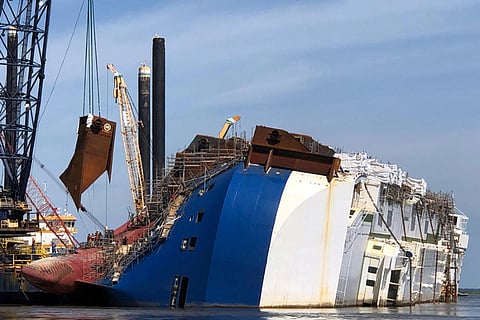

It was a recent picture of the car carrier Golden Ray, lying on her side and being sawn up by the salvors, that got me thinking that there really seems to be something of a problem in keeping modern car carriers the right way up, despite all their loading computers. They look a bit top-heavy, but quite a few have alarmingly listed in embarrassing places, seemingly because nobody seems entirely sure of the weight of the vehicles they are rushing aboard.
Loading computers hadn't been invented when we sailed off to the other side of the world and back again, requiring no end of long-hand calculations as the all-important metacentric height was endlessly computed. It was usually the second mate's job, or at least he would get the blame if the ship was a trifle stiff on passage.
Our ships took a general cargo from up to half a dozen ports in the UK and Europe for discharge in perhaps three or four ports in Australia and New Zealand, bunkering en route at Aden or Curacao. Stability tended not to be a problem outwards, as there was invariably plenty of heavy machinery, steel or "long iron" that could be stowed in the lower holds that would give us plenty of bottom weight, with every conceivable sort of product loaded on top and in the tweendecks.
Homeward bound, with the ship frozen down, stability depended very much on the cargo mix, which tended to vary with the seasons. The ideal was a couple of lower holds of butter, which made subsequent life much easier, but carcase lamb (think about the hole in the middle of it) was a bit more problematical. Cheese was a good old weight in its crates, while apples, because of all their packing, tended to be a bit lighter. Wool was not a heavy cargo, being stuffed in where space could be found, although in later years, the individual bales became far denser.
The homeward passage was sometimes made a lot easier when perhaps three holds were bottomed out with ingots of zinc from Port Pirie or Risdon near Hobart, this being floored off with dunnage before the freezers got to work.
Stability, when cargo was being loaded and discharged, along with the shortish voyages between ports around the various coasts, was thus something of a complex and moveable feast. It required constant calculation. Also, significant contributors to the ultimate result were the contents of the various oil and fresh water tanks, mostly in the double bottoms.
The bunker situation at any one time tended to be a closely guarded secret presided over by the chief engineer, who often seemed reluctant to part with this crucial information, when the second mate came calling. It will be realised that the daily consumption of fuel and water on passage also affected both the stability of the ship and its trim, so that all had to be part of the calculation.
Every ship in our fleet of about thirty had different stability characteristics, some more docile than others. Some of the newer vessels, elegant and streamlined, were rather harder to stow than older pre-war tonnage, which was flush-decked, without the lavish superstructure that everyone admired. We used to suggest that their designers really didn't understand the first principles of ship stability and were only interested in their looks, but that was probably unfair.
We may not have had the amazing loading computers they use today, but we were not entirely left to our adding machines and slide rules. The ships each were supplied with a device called a "Ralston Indicator," which could be used, usually to plan cargo stows and keep a check on the second mate's arithmetic. These were rather beautiful flat mahogany boxes in which was to be found a large brass plate with a general arrangement plan of the ship and her tanks inscribed upon it.
Also to be found within was a collection of little boxes with small brass weights, each carefully machined to correspond to a number of tons. It looked, at first glance, like a children's game, but it had a more serious function.
The weights, some of which were quite small and fiddley, were placed on the corresponding compartments, to "load" the ship with both cargo and liquids. Then using a system of levers, the whole table could be balanced longitudinally to indicate the righting moments at any one time and laterally to provide the ship's trim. It was a useful device as you could fairly rapidly see what the effect of filling or emptying the fore or after peak tanks might be, or what that unexpected 300 tonnes of late cargo was going to do to the stability, at any stage of the voyage.
The only problem was that after spending ages loading the ship with its umpteen little weights, eventually finding out what the stability was, you had to put it all away again as the slightest motion of the ship on a coastal passage would have the whole lot sliding all over the place. Some officers who were better than others at their sums would tell you they could work out the stability longhand faster than fiddling around with little bits of brass. Mind you, we never trusted the Ralston anyway, and still were required to work out the vital statistics on paper. Maybe we were just lucky, but we never saw one of our ships on its side, being chopped up by salvors.
Submissions wanted! Do you have an exciting, amusing or downright dangerous anecdote from your time in the maritime world? Each week, we will feature new personal experiences from across the globe. Submissions to: marinfo@baird.com.au.
